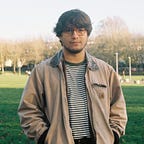Photography: Pursuing the Present and Future via the Past
Since the arrival of COVID-19, millions of people from across the globe have found themselves being under a life of lockdown at one stage or another. The sense of being trapped in your own home has pushed people to explore areas other than outside their own front door — their minds, their imagination, their creativity, their emotion, their lifestyle.
I found myself amongst the crowd of people trying their hardest to explore new areas of interest, or even rekindle old ones. For some, it included dieting, exercise and health. For me… a chance to explore the creativity I had always wanted to express. Throughout my teens and early adulthood, I had a life comparable to that of a tortoise pursuing a career as an Olympic sprinter. It takes no genius to know that that tortoise is more suited to lounging underneath a large lightbulb to the soundtrack of lettuce crunching between his teeth. Having graduated university to be immediately thrown into a lockdown-ed and unemployed life, it was the perfect time for me to find my lightbulb and lettuce.
I decided to rekindle the spark of an old interest of mine — photography. I revisited old memories of visiting photography exhibitions with my father, an ex-photojournalist, and sifting through old national geographic and various other photography books and magazines in my attic. At 12 I purchased my first DSLR and still clearly remember my father explaining to me the criteria needed to work a camera and capture the perfect image.
This time it was different. I was keen to explore the world of analogue photography. I hastily purchased a few rolls of the cheapest film I could find and asked my father to dig out a couple of his old cameras for me. I ended up with a Fujifilm point and shoot, which was previously given to me as a young child. It was a capricious reunion. However, I was stupidly naive enough to believe that this cheap, hunk-of-junk, plastic box and borderline children’s toy was an adequate piece of apparatus to capture and forever hold one’s visual memories. The 3 days I had waited to receive the photographs back from the lab felt like an eternity. I was ecstatic to become the modern neo-hipster who can be found sipping an Arabic coffee in a Shoreditch watering hole with a vape in hand.
Once I had gotten my photos back I was sliced with the double-edged sword of anger and sadness. Only two-thirds of my photos were returned. This was due to heavy light leaks finding its way to the film from the ‘if it was a pet, I’d have it put down’ camera. This lead to sadness. This was quickly overcome by the anger, stemming from the fact that I had spent a combined price of £14 on buying and developing a roll of film to only receive some poorly lit photos with randomly generated visions of the aurora borealis on them.
After acquiring concrete evidence that the Fujifilm point and shoot camera was no better at taking photos than a plastic lens inserted into a toaster on bagel mode, I realised that I should use a different camera. The other camera that was handed down to me from my father was a Canon EOS Kiss, a model released in Asia in the early/mid-90s. This was an SLR camera and almost identical to the modern DSLRs of today. It featured a flash, auto-focus, telescopic lens, auto film loading, auto-advance, auto rewind. Kind of, auto everything. Although the camera produced sharp and professional photos it was not what I was after. I wanted something mechanical, something that isn’t, well, auto.
“I know I have the convenience of an iPhone with a modern digital camera, but ya know.. I just find analogue photography to be the slow deteriorating bridge that connects our forefathers to our fathers to us. Ya know??”
After scouring the internet more intensely than a Love Island wannabe scours Tinder, I found the perfect camera. The Minolta 7s. I had decided that I wanted a mechanical and ‘classic’ camera. Something without all of the autos and something that closely resembles the camera emoji. And when I found it I didn’t even hesitate. Before I knew it it was in my hands and shooting, still, the cheapest film stock on the market.
In this modern era, it is extremely easy to come across as pretentious. “Oh my god, why do you make it out that you’re Pink Floyd’s number one fan when we all know your only Spotify playlists only consist of Dua Lipa, Drake and Khalid. Stop pretending you’re cool or ‘edgy’ by liking old things. Let me guess, you were ‘born in the wrong generation’.”
It is very easy to come across as ‘that guy’ when chasing an interest, or hobby, such as analogue photography. My reasoning for it was much more than the stereotypical cool kid who rolls up his jeans, wears Dickies and listens to bedroom pop.
“I simply want to create.”
A relatively morbid question I frequently ask myself is “when I die, will I be remembered?”. The thought of the answer being no is something that I proactively seek to prevent. Creativity is an outlet of an individual’s interest, perception and expression. I want to be able to produce something that will last longer than myself. For me, film photography just hits differently than digital. Each shot counts, and more importantly, costs. This forces you to choose that decisive moment in which to hit the shutter and allow time to stand still. Analogue photography is an art form. It is a non-instant method, somehow still thriving in an instant world.
